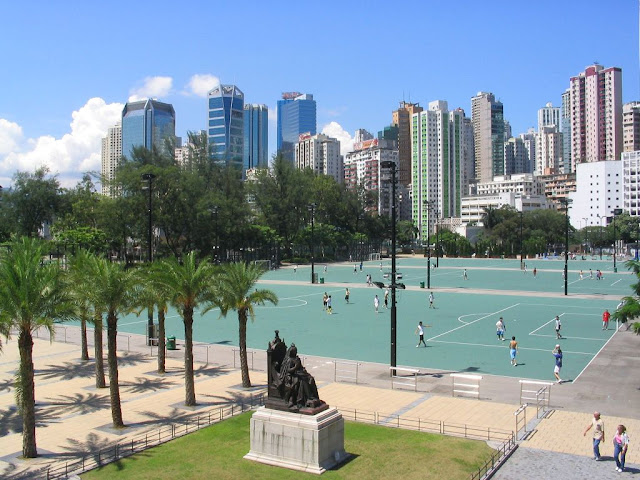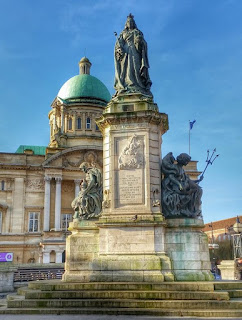This statue of Queen Victoria by Louis-Philippe Hébert, was placed on Parliament Hill, Ottawa, Canada in 1901.
This statue to Queen Victoria in Kolkata, India forms part of the Victoria Memorial, a large marble building and park.
It is the work of Sir Thomas Brock KCB RA, an English sculptor, and medallist, whose works include the monument to Queen Victoria in front of Buckingham Palace.
Australia to Cornwall . . .
In the Australian state of Victoria, the Queen Victoria Gardens are Melbourne's memorial to Queen Victoria.
Footprint of Queen Victoria to mark her visit to St Michael's Mount, Cornwall in 1846.
"As well as a sign on the wall giving the date of her visit, there is a brass shoe print showing where she stepped onto the island. This is shaped just like the bottom of her shoe that day and it has always amazed me how absolutely tiny her feet were."
Singapore to Hong Kong . . .
Statue of Queen Victoria in the Istana Grounds, Singapore.
The State Room is the seat and office of the President of Singapore in the Istana (Presidential Palace). When it was the sitting room of Sir Shenton Thomas, he had a statue of Queen Victoria at one end of the room. The statue was later removed to make way for what is now the Presidential Chair and two state flags: the National Flag and the Presidential Standard. The statue of Queen Victoria now stands at the end of the Victoria Pond located south of the Istana Grounds.
The bronze statue of Queen Victoria is by Mario Raggi, now installed at the main entrance of Victoria Park, in Hong Kong.
The sculpture was cast in Pimlico, London, and originally located at the centre of Statue Square, where it was unveiled by then Governor William Robinson on 28 May 1896, the day officially appointed for the celebration of the 77th birthday of the Queen. During the Japanese occupation of Hong Kong, it was taken to Japan to be melted down, along with other statues from the square. After the war the statues were brought back to Hong Kong, and in 1952 Queen Victoria's statue was restored and placed in Victoria Park.
From the West to the East
From the rich to the poor
Victoria loved them all . . .
These lines form the last verse of "Victoria".
Canada to India
Australia to Cornwall
Singapore to Hong Kong
From the West to the East
From the rich to the poor
Victoria loved them all
Victoria, Victoria, Victoria, 'toria
Victoria, Victoria, Victoria
Raymond Douglas Davies
Victoria lyrics © Warner/Chappell Music, Inc
It is the opening track on the band's 1969 concept album Arthur (Or the Decline and Fall of the British Empire).
In Ray Davies' satirical style, the lyrics juxtapose the grim realities of life in Britain during the 19th century with the paternalist aspirations of the British Empire in the Victorian age, and expresses the simple adulation of queen and country by the downtrodden working class.
Sex was bad, called obscene
And the rich were so mean
Stately homes for the Lords
Croquet lawns, village greens
Victoria was my queen
Victoria, Victoria, Victoria, 'toria
In a land that I love
Though I am poor, I am free
When I grow I shall fight
For this land I shall die
Let her sun never set
Victoria, Victoria, Victoria, 'toria
Victoria, Victoria, Victoria, 'toria
So, who owns history?
The story behind the concept album Arthur (Or the Decline and Fall of the British Empire) is a shared history. This story was shaped by Ray Davies and Julian Mitchell's take on aspects of modern British identity. British production company Granada TV approached Ray Davies in early January 1969, expressing interest in developing a movie or play for television. Davies was to collaborate with writer Julian Mitchell on the "experimental" programme, with a soundtrack by the Kinks to be released on an accompanying LP.
This shared understanding of the shaping power of stories, the stories, events, opportunities and ideas that shape identity in the era of a decline and fall of the British Empire, expose how the founding narratives are shaped through nostalgia, fantasy and denial of actual events. The original project was abandoned, at the last minute almost, due to production funding problems.
But, in the end, an acclaimed concept album was produced.
Rolling Stone:
“You look like a real human being but . . .” “He got feet/ Down/ below his knees/ Hold you in his arms yeah you can feel his disease . . .”
It’s all over for England. They’ve had their history and it’s been written in books; they’ve fought their wars and buried their heroes. The English have owned the world and jettisoned their empire, and all that’s left is — rock and roll. “England has got all the bad points of Nazi Germany, all the pompous pride of France, all the old fashioned patriotism of the old Order Of The Empire. It’s got everything that’s got nothing to do with music . . . the poxy little shit-stained island.” So said Pete Townshend.
And the Kinks’ answer, like the Band’s answer to the American questions, is that a band makes its music out of whatever history has to offer. Arthur has the same guts as the Band’s new album, that same reach back into the past, the same sense of age — like the Band, the Kinks can play the role of man near the end of his life when they themselves are merely in their twenties. Arthur is more fun, more cutting, and in the end simply hilarious because whatever England was, it isn’t any more, and the Kinks are set free of all responsibilities. Christine Keeler died for their sins.
The Kinks are fun. Ray belts out “Victoria,” and manages to sound pompous and fat — just like the girl herself — while doing so. The band drops off all restraints and finally performs like a real rock and roll band instead of like a bunch of old ladies. Dave Davies takes solos with delightful horns as a back-up, not to display virtuosity (which he has) but because the songs are too much fun to stop. On “Mr. Churchill Says” the band moves effortlessly into a three or four part number, changing the tempo, the mood, and the melody while never losing a superb dancing beat. Many of the songs display that sort of genius: “Shangri-la,” “Australia,” and more. The complexity of the compositions doesn’t intrude because these delights are composed, not constructed, as were “Happiness Is a Warm Gun,” “A Day in the Life,” or the collages on Abbey Road. The music’s like a verbal and instrumental jam session with divine inspiration as a rhythm section.
The music will move anyone who listens, because there is such an enormous mount of pathos in what Ray Davies has done. He’s presented the last hundred years of English history through the eyes of one little man who never meant a thing to the rest of the world — as if Sinclair Lewis had followed Babbitt from birth to death and then made it into a musical comedy.
Less ambitious than Tommy, and far more musical — no fillers, no waste tracks, not a matter of ideas but of perceptions worked out by bass, drums, voices, horns and guitars — Arthur is by all odds the best British album of 1969.
It shows that Pete Townshend still has worlds to conquer, and that the Beatles have a lot of catching up to do.J. B. Young - Rolling Stone - November 1, 1969
The backstory to the album concept is partially inspired by the Davies brothers' older sister Rose, who emigrated to Australia in 1964 with her husband Arthur Anning.
Her departure devastated Ray Davies, and it inspired him to write the song "Rosy Won't You Please Come Home", included on the 1966 album Face to Face. The lead character in the album, the fictional Arthur Morgan—modelled after Anning—is a carpet layer whose family's plight in the opportunity-poor setting of post-war England is depicted.
Writer Julian Mitchell detailed the story line and characters in depth, explaining in the liner notes for the album's LP release:
Arthur Morgan ... lives in a London suburb in a house called Shangri-La, with a garden and a car and a wife called Rose and a son called Derek who's married to Liz, and they have these two very nice kids, Terry and Marilyn. Derek and Liz and Terry and Marilyn are emigrating to Australia. Arthur did have another son, called Eddie. He was named after Arthur's brother, who was killed in the battle of the Somme. Arthur's Eddie was killed, too—in Korea.Davies would later comment in his autobiography, X-Ray, that Anning later "told me that he ... knew it [Arthur] had been partly inspired by him ... [it] reminded him of home ... I told Arthur that I felt guilty for using him as a subject for a song, but he shrugged off my apology, saying that he was flattered." With an underlying theme of nostalgia, the songs describe the England that Arthur once knew ("Victoria", "Young and Innocent Days"), the promise of life in Australia for one of his sons ("Australia"), the emptiness of his superficially comfortable life in his home ("Shangri-La"), the resolve of the British people during the Second World War ("Mr. Churchill Says"), the privations that marked the austerity period after the war ("She's Bought a Hat Like Princess Marina"), and the death of his brother in World War I ("Yes Sir, No Sir", "Some Mother's Son").
It is events that provide facts, the happening stuff that makes historical interpretations and representations possible. When history gets buried, the White Legends comes back to haunt the present, deform our understandings of the wider world, and in so doing, deform an understanding of ourselves.
Monument to Queen Victoria in Liverpool
There are four groups of figures around the pedestal, representing agriculture, commerce, industry and education. A large (14.5ft) statue of Queen Victoria is at the centre, centred in four groups of columns which support a baldacchino-like open dome. Atop the column groups are four allegorical figures representing justice, wisdom, charity, and peace. Atop the dome itself is a large figure representing fame.
Statue of Queen Victoria, Victoria Square, Hull.
The 35ft statue of Queen Victoria, designed by the architect J S Gibson and the sculptor H C Fehr, dominated the centre of the new city square following its unveiling by the Prince of Wales on 12 May 1903. The new square soon became known as Queen Victoria Square. After standing alone for a number of years, the statue was raised into the air to accommodate new subterranean municipal lavatories.
















